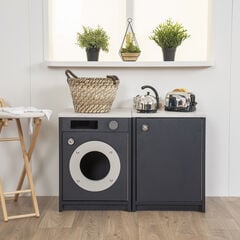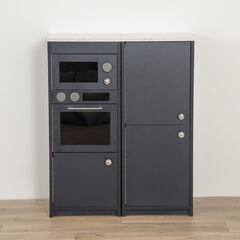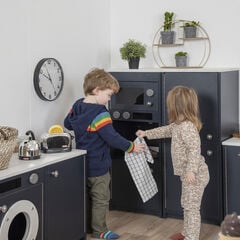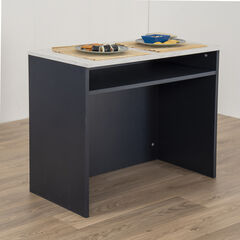Home is where the heart is – The home corner
In many families, it’s true that home is where the heart is. You will find them gathered together around the kitchen table or breakfast bar. It can be a place where they:
- Huddle first thing in the day to ‘wake up’.
- Dream their dreams of how they will spend their day.
- Talk through their plans with family.
These same families will gather at the end of the day, back in the same kitchen to chat, share stories and laugh about their day. They may each have jobs to do while they come together as a team. These may include:
- Putting clothes in the washing machine, while someone else selects the veg to defrost.
- Little ones may open a cupboard to select the items to set the table crockery or collect the cutlery.
- Searching in the higher cupboards to find their favourite mug or crystal tumbler for a glass of something cold.
In these families, it really is the heart of the home. Where secrets are spilled, worries are halved, and announcements are shared.
Sadly, this is not the case for every child or family. It can often be the opposite. A place of high stress that highlights the worry and concerns of the family structure or situations and issues that some families may face.
This makes it one of the most important play spaces we share with young children. A place we can create to highlight the amazing possibilities of gathering together, sharing our thoughts, expressing our feelings and somewhere we feel that we belong.
Why a Home Corner?
When we try to inspire fabulous role play, we can assume this kind of play to fit into three main categories:
- Occupational role play where children assume the character of a doctor, firefighter, teacher, hairdresser, or fisherman.
- Fantasy role play where we might find unicorns, superheroes, or dinosaurs.
- The third main type of role play is situational.
Each can be highlighted through play in our spaces. Anywhere in our settings, indoors or outdoors, in a corner, a learning zone or we can create a place just to engage in one of these types of experiences.
However, my instinct always leads me to encourage us to see the ‘home’ we create for our children to be of the highest value. It should be the best of the best and remain a constant, not changed to serve a wider purpose.
Being, becoming and belonging
Bowlby claimed that children need to be emotionally attached to someone who can provide them with security, safety, and reassurance. In our environments, it’s often a challenge to find that secure base in a person. Our children share their person with many other little humans.
Maybe think about having a ‘home’, not stuck in a ‘corner’, but one that is a haven of fabulousness, not just for playing roles. It can offer a secure base to have a ‘home play’ space that celebrates all it can offer. It can become the place that is a reliable base for any child to feel reassured. One that promotes security confidence, competence, and resilience. If we take time to really consider why it’s an important place for play, then we are setting up a ‘home play situation’ that is valuable, meaningful, and will have an impact on the development of the children emotionally.
Stages and types of play
If we have a home play area, often a kitchen base that has room, we can support all stages of social play.
A child can choose to sit in unoccupied play, planning or trying to remember how they will make the cake. They can think about what they need to gather and know that when they move into action they could become a chef, a baker, or pot washer.
If we have units that are child size, they can stand with ease in a solitary situation and wash the veg for soup, put the pan on the stove, then choose to have a cup of tea and sit on the sofa, keeping an eye on the pot. Why would I ever feel the need to leave?
Enriching with authentic resources
If the children can engage with the units, they can do numerous tasks such as:
- Filling the drawers with folded linen, napkins, and table runners.
- Sort and match cutlery into different sections.
- Organise cupboards with, real china, crockery, and vessels to drink from.
These tasks may lead to participative, associate, and cooperative play opportunities.
Imagine the child’s excitement when encountering the following situations:
- Opening a drawer and finding party invites, balloons, candles, and wrapping paper.
- Seeking out a measuring tape or sewing box from a cupboard.
- Under the sink they might find brushes and cloths to make shoes shine, pegs to help hang up the washing, or a tool kit to fix the bikes in the garden.
There are so many items, little provocations kits, that can be placed in this space to enrich and enhance every child’s learning, not just pots, pans, and plastic food.
Language opportunities
To elevate to the next level, extend the luscious language that children need to be surrounded by and give them the opportunities to learn new vocabulary and use it. Imagine the children coming in one day to this glorious home corner, to find a bouquet set up at the table with a candelabra and chandelier, or under the table a basket of kittens. What else might ignite this spark?
Home Corner play is hugely important. I hope one day that we no longer have ‘sorry spaces’ for our children to play in.
Click here for more Home Corner resources
With thanks to Alice Sharp.
Alice is an Early Years specialist working with education organisations around the world. Originally a primary school teacher, she is an author, trainer and specialist in providing exciting provocations for children’s learning.






















